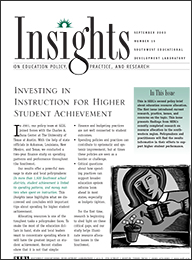Investing in Instruction for Higher Student Achievement
Introduction
In 2001, our policy team at SEDL joined forces with the Charles A. Dana Center at The University of Texas at Austin. With the help of state officials in Arkansas, Louisiana, New Mexico, and Texas, we conducted a two-year finance study on spending patterns and performance throughout the Southwest.

Our results offer a powerful message to state and local policymakers: In more than 1,500 Southwest school districts, student achievement is linked to spending patterns, and money matters when spent on instruction. This Insights issue highlights what we discovered and concludes with important tips about spending for higher student achievement.
Allocating resources is one of the toughest tasks a policymaker faces. To make the most of the education dollars in hand, state and local leaders want to concentrate spending where it will have the greatest impact on student achievement. Recent studies show that it is not that simple:
- Finance and budgeting practices are not well connected to student outcomes.
- Spending policies and practices can contribute to systematic and systemic improvement, but at times these policies are seen as a barrier or challenge.
- Critical questions about how spending practices can support broader education system reforms loom ahead in most states, especially as budgets tighten.
For the first time, research is beginning to shed light on these critical gaps, and our study helps illuminate resource allocation issues in the Southwest.

